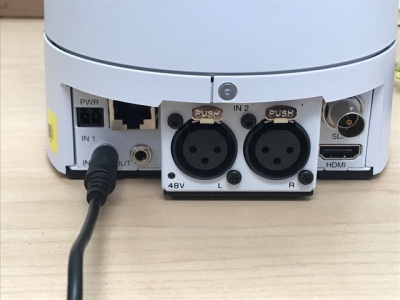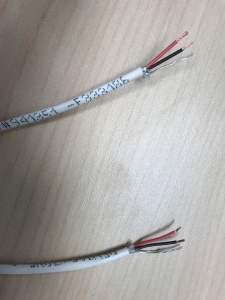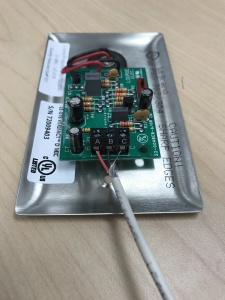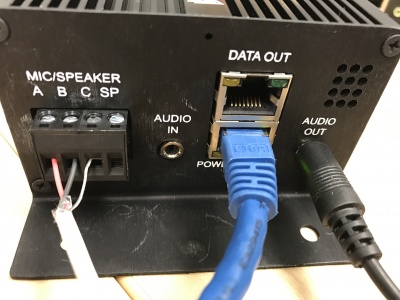Installing an Axis V5914/V5915 with a Louroe Verifact D Microphone
Revision as of 15:50, 6 April 2020 by IVSWikiBlue (talk | contribs) (→Installing and Connecting the Microphone)
Required Parts And Tools
- Axis V5914/V5915
- Louroe IFPX
- 3.5mm (Male to Male) Audio Cable
- Louroe Verifact D Microphone
- S2 TT10 Torx security bit
- Wire Stripper
- Toggle Bolts (If mounting to drop ceiling tile)
- Wall Dog Screw Anchor
- Drill bit and drill
- Phillips head drill bit or Phillips head screwdriver
- Small Flat head screwdriver
- B Connectors
- Cat5/6 Patch Cable (7ft-15ft recommended)
- 22/2 Gauge Wire
- Fish Tape or Glow Rod
- 1 Mud ring if mounting to drywall, Datacom box if mounting to hard surface (ex. Cinderblock)
- Drywall Saw
Installation Instructions
Drop Ceiling Mount WARNING
- The combined weight of the camera and mounting bracket is approximately 1.7 kg (3.7 lb.).
Make sure that the ceiling material is strong enough to support this weight. NOTICE
- The ceiling tile should be 5–60mm (0.2–2.4in.) thick.
- Remove the ceiling tile in which the drop ceiling mount is to be fitted.
- Drill a 7 mm (9/32 in) hole in the ceiling tile.
- Remove the tripod screw from the mounting bracket.
- Attach the short end of the threaded rod to the camera and tighten.
- Assemble the camera, ceiling tile and the mounting bracket, and tighten the nut.
- Route and connect all cables to the camera.
- Connect the power supply to a mains power outlet (100–240 VAC).
- Install the ceiling tile with the camera mounted on it.
Wall Mount
- Use a stud finder to locate wall studs, and determine proper placement for the L bracket. Make a mark for the 3 screw holes on the short end of the L bracket, and the area to fish the cables. (We will be using 3/16" wall screws and anchors here).
- Drill these holes for the anchors, and use a walldozer to drill a hole to fish the cables.
- Place the anchors, screw the bracket down, and fish our cables (power, network, 3.5mm audio, possible 22/2 for I/O, and possible HDMI cables) down the ceiling through the hole under our bracket.
- Place the V59 onto the bracket, and secure it with the tripod screw from underneath.
- Route and connect all cables to the camera (network, audio, power, possible HDMI, possible I/O cable).
Installing and Connecting the Microphone
- Locate the network drop above the ceiling either being a male Ethernet end (service loop) or a biscuit jack. This will have been ran back to the POE switch. If the switch does not have POE, a POE injector will need to be installed at the network closet.
- Using a set of anchors and screws, mount the Louroe IFPX above into the drywall above drop ceiling. (Note, if no drop ceiling make other arrangements to mount the IFPX.)
- Connect the network drop into the RJ-45 (f) on the IFPX that reads Power+Data In (You may need an additional patch cable if terminated with an keystone jack) When connected you should see activity on the link lights. If no link lights appear, ensure that POE is enabled on your POE switch and that the network drop is plugged in.
- Using the CAT5/6 patch cable, connect the camera to the RJ-45 (f) on the IFPX labeled Data Out to the RJ-45 input on the Axis V5914/V5915. When connected, you should see the LEDs light up on the unit. After approximately 1 minute, all should be green. If not, check connections.
- Take the 3.5mm Male to Male audio cable and connect it from the 3.5mm jack labeled AUDIO OUT on the IFPX, into the “AUDIO IN” on the Axis V5914/V5915 (See Picture).
- Strip the jacket off the 22/2, revealing the red, black, and common (bare wire) on both sides of the cable. Remove the string and plastic casings covering the red and black cables. Strip the red and black jackets off the wire exposing the copper. Cut copper evenly on both ends (See picture)
- Cut a hole into the drywall, large enough to fit the mud ring into it securely. Feed one end of the the 22/2 audio cable through the hole. (If mounting on a hard surface, attached Datacom box to the wall). Connect the audio cable to the Verifact-D phoenix terminal as follows; Red to A, Black to B, Common (bare wire) to C (See Picture)
- Connect the other end of your 22/2 cable to the terminal on the IFPX labeled MIC/SPEAKER A B C SP. The connections will be as follows; Red to A, Black to B, Common (bare wire) to C (See Picture)
- Align Verifact-D with mud ring or Datacom box and screw in securely.















